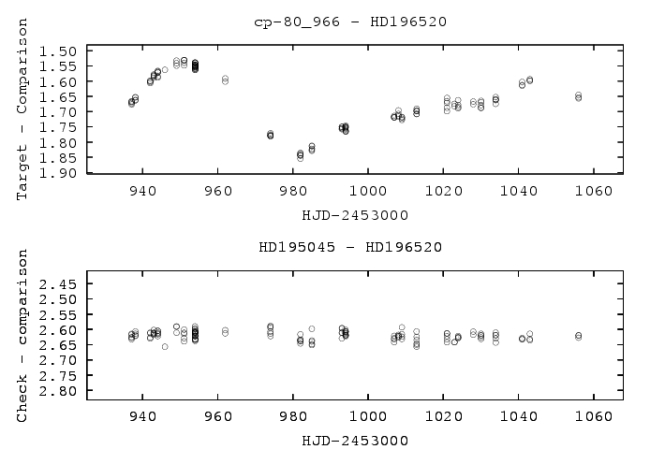| Article in PDF |
"Peremennye Zvezdy", Prilozhenie, vol. 6, N 29 (2006) |
CPD-80 966: a Red Semi-Regular Star in Octans
J. L. Innis#1, T. G. Kaye#2, D. W. Coates#3
#1. Brightwater Observatory, Howden, Tasmania, Australia
#2. Spectrashift, Chicago, U.S.A.
#3. School of Physics, Monash University, Melbourne, Australia
#2. Spectrashift, Chicago, U.S.A.
#3. School of Physics, Monash University, Melbourne, Australia
| ISSN 2221–0474 |
Received: 19.11.2006; accepted: 22.11.2006
(E-mail for contact: brightwater@iraf.net)
| ||||||||||||||||||||||
Remarks: |
| CCD BVR observations of the far southern star CF Octantis, commencing in mid
2006
at the Brightwater Observatory, Tasmania, showed that the field star CPD-80 966
was
varying
significantly from night to night. Neither SIMBAD nor the GCVS indicated that the
variability of this star was known, so observations were continued to establish the
nature
and timescale of the variation.
During the course of the observations the ASAS database was consulted, where the star appears (Pojmanski & Maciejewski, 2005) as a miscellaneous variable, of period 87.6 d, and a V range from 9.32 to 9.63. Our instrumental V data are shown in the figure. Each plotted point represents the mean of four 30-second integrations. We used HD 196520 as the comparison star. The V and (B - V) magnitudes of HD 196520 are taken as 7.60 and 1.07 respectively (Innis, Coates and Thompson, 1997). CPD-80 966 is significantly redder, near (B - V) = 1.8 (preliminary value). Our colour term in the transformation to V standard magnitudes is small, based on observations of standard stars in the (B - V) range from ~0 to ~1.4. If the transformation remains linear up to (B - V) = 1.8, the correction would be ~0.004 mag for our measurements of V (CPD-80 996 - HD 196520). However as this has yet not been established, we present instrumental differential magnitudes in this report. Differential extinction corrections have been applied. The check - comparison star differential magnitudes are shown in the lower panel, and have a root mean square value of 0.015 mag. The mean light level we measure for CPD-80 966 is somewhat brighter than that reported in Pojmanski and Maciejewski (2005), but inspection of the ASAS on-line database shows that the mean light level is itself variable. The time between maxima in our data is close to 95 d, which is the value we report here, but again, inspection of the ASAS datbase shows the period is somewhat variable. The star CPD-80 966 hence appears to be a semiregular variable. We aim to present a more complete account, incorporating the multicolour photometry and a more detailed analysis, in the near future. We have made use of SIMBAD of the CDS, the ASAS database, the NASA ADS service, and Muniwin by David Motl. |
| References: |
| Innis, J.L., Coates, D.W., Thompson, K., 1997, MNRAS, 289, 515
Pojmanski, G., Maciejewski, G., 2005, Acta Astronomica, 55, 97 |
Light Curve
Upper panel: V light curve of CPD-80 966 relative to HD 196520. Lower panel: V light curve of check star HD 195045 relative to HD 196520. The mean (and standard deviation) of the data in the lower panel is 2.620±0.015 mag. |